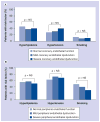Endothelial function as a functional expression of cardiovascular risk factors
- PMID: 20550469
- PMCID: PMC2911781
- DOI: 10.2217/bmm.10.61
Endothelial function as a functional expression of cardiovascular risk factors
Abstract
Traditional cardiovascular risk (CV) factors based on the Framingham study have been used to estimate the risk of CV events and determine target cholesterol levels for primary prevention. Recently published systematic reviews have, however, demonstrated that the Framingham risk score is limited in certain cohorts and requires adjustment. Indeed, traditional CV risk factors fail to predict the development of coronary heart disease in 25-50% of cases. This underscores the complex interplay between traditional CV risk factors, genetic predisposition and other atheroprotective factors present in individuals of different populations in predicting CV events. Endothelial dysfunction, a functional expression of the inherent atherosclerotic risk representing an integrated index of both the overall CV risk-factor burden and the sum of all vasculoprotective factors in an individual, may serve as the missing link between CV risk factors and atherosclerotic disease. Endothelial function measurements may aid in future prediction of CV events and help identify high-risk patients for targeted therapy as well as provide a primary therapeutic end point for clinical follow-up of these patients. Recently introduced reactive hyperemia peripheral arterial tonometry is emerging as a promising tool in endothelial function measurement and CV risk stratification.
Figures



References
-
- Wang TJ, Gona P, Larson MG, et al. Multiple biomarkers for the prediction of first major cardiovascular events and death. N Engl J Med. 2006;355(25):2631–2639. - PubMed
-
- Bonetti PO, Lerman LO, Lerman A. Endothelial dysfunction: a marker of atherosclerotic risk. Arterioscler Thromb Vasc Biol. 2003;23(2):168–175. - PubMed
-
- Furchgott RF, Zawadzki JV. The obligatory role of endothelial cells in the relaxation of arterial smooth muscle by acetylcholine. Nature. 1980;288(5789):373–376. - PubMed
-
- Yanagisawa M, Kurihara H, Kimura S, et al. A novel potent vasoconstrictor peptide produced by vascular endothelial cells. Nature. 1988;332(6163):411–415. - PubMed
Publication types
MeSH terms
Substances
Grants and funding
LinkOut - more resources
Full Text Sources
Other Literature Sources
Medical
